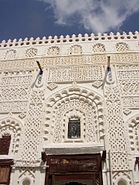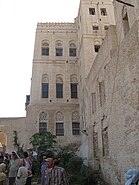Zabid(Arabic:زَبِيد) (also spelledZabīd,ZabeedandZebid) is a town with an urban population of around 52,590 people, located onYemen's western coastal plain. It is one of the oldest towns in Yemen, and has been aUNESCOWorld Heritage Sitesince 1993. However, in 2000, the site was placed on theList of World Heritage in Danger.The town was the capital of several ruling dynasties in Yemen over many centuries.
Zabid
زَبِيد | |
|---|---|
Town | |
Clockwise from top: Citadel Zabid skyline,Al-Iskanderiya or Citadel Mosque,Administration building within the citadel, architecture pattern, historic town | |
| Coordinates:14°12′N43°19′E/ 14.200°N 43.317°E | |
| Country | |
| Governorate | Al Hudaydah Governorate |
| District | Zabid |
| Time zone | UTC+3(Yemen Standard Time) |
| Official name | Historic Town of Zabid |
| Criteria | Cultural: (ii), (iv), (vi) |
| Reference | 611 |
| Inscription | 1993 (17thSession) |
| Endangered | 2000–... |
History
editThe town is one of the oldest in Yemen. It was originally a village known as al-Husayb that was inhabited by the Asha'ir tribe.[1]It later took on the name of theWadiZabid, the valley to its south.[1]According to tradition, the town's early history is associated withAbu Musa al-Ash'ari,one of thecompanionsof the Islamic prophetMuhammad,who is said to have built the al-Asha'ir Mosque as the fifth mosque in thehistory of Islam.[2]
The present town was created circa 820 by Muhammad ibn Abdallah ibn Ziyad, the founder of theZiyadid dynasty,who had been sent by the Abbasid caliph al-Ma'mun to suppress a rebellion of the Asha'ir and Akk tribes.[1][3]It became the capital of the Ziyadids (up to 1016) and continued to serve this role under their successors, theNajahid dynasty(from 1022 to 1158) and theMahdids(1158 to 1174).[1]During this time the city grew in importance. Its mosques, including theal-Asha'ir Mosqueand theGreat Mosque,became centers of Islamic learning.[1]Its location on the road betweenMeccaandAdenalso granted the city economic prosperity.[1]
In 1067, during thepilgrimage to Mecca,theBanu Najahclan under Sa'id Ibn Najah, the prince of Zabid, attacked the travel party of theSulayhidsultan,Ali al-Sulayhi,and his wifeAsma bint Shihab.They killed Ali and took Asma prisoner. She was sequestered in a secret prison in Zabid, and the severed head of her spouse was reportedly planted on a pole visible from her cell.[4]After a year's imprisonment, she managed to get a message through to her son and daughter-in-law inSanaa,and her son stormed Zabid and freed her.
Ali ibn Mahdi, a native of the Yemeni highlands, founded theMahdid dynastyin theTihamaregion. Al-Himyari and his followers burned down several districts north of Zabid. He had sworn to put the Abyssinians into slavery and ordered his men to kill everyone, including the handicapped.[5]Out of desperation, the people of Zabid sought assistance from theZaydi imamAhmed ibn Sulaymanagainst al-Himyari. The Zaydi imam orderedFatiq IIIto be executed on account of his allegedhomosexuality.Fatiq III was either killed by the Imam, the Mahdids, or his own soldiers. With this event, the slave dynasty came an end and the Mahdids took over Zabid in 1158.
After theAyyubidstook control of Yemen in 1174, Zabid continued to be the economic and political center of the region.[1]Under theRasulid dynasty(1229–1454), the official capital was moved toTa'izzbut the rulers continued to use Zabid as a winter residence. The city reached its apogee during this period and had a larger number of palaces, gardens, and religious institutions than any other city in Yemen.[1]Al-Khazraji,a local 14th-century Arab writer, claimed that the city counted between 230 and 240 mosques.[1]Even today, the city reportedly has the highest concentration of mosques in Yemen.[6]
Hadım Suleiman Pashaextended theOttoman Empire's authority to include Zabid in 1539.[7]Zabid became the administrative headquarters ofYemen Eyalet.[7]
Today, however, Zabid is at the intellectual and economic margins of modern Yemen.[8]Muhammad Abdul-Wali's novelSana'a: An Open Citytells the story of a young man who traveled to Zabid in the mid-20th century and was surprised to find the town had become a backwater.
Geography
editZabid has an urban population of around 52,590 persons. It is located on Yemen's western coastal plain, in the Tihama region.[9]
World Heritage Site
editZabid was declared aWorld Heritage SitebyUNESCOin 1993.[10]Zabid's Great Mosque occupies a prominent place in the town. The vestiges of its university can also be visited. In 2000, Zabid was listed on theList of World Heritage in Danger;the listing was made at the behest of the Yemeni government due to a state of poor upkeep and conservation. According to aUNESCOreport, roughly "40% of the city's houses have been replaced by concrete buildings, and other houses and the ancient souk are in a deteriorating state.[11][12]The ongoingYemeni civil waralso poses a threat to Zabid's heritage. Some historic homes were damaged bycoalitionbombing in 2015.[13]Further concerns were raised in 2018 as fighting drew near to the city.[14][13]
Economy
editAs of 1920, Zabid was one of two places inArabiagrowingindigo.Zabid also grows and producescotton.[15]TheBritishcite tribal disputes as dampening the economy in Zabid during the early 20th century.[16]
Gallery
edit-
House and street in historic Zabid
-
Houses in historic Zabid
-
Al-Kamiliya Mosque
References
edit- ^abcdefghiSadek, Noha (2002)."Zabīd".InBearman, P. J.;Bianquis, Th.;Bosworth, C. E.;van Donzel, E.&Heinrichs, W. P.(eds.).The Encyclopaedia of Islam, Second Edition.Volume XI:W–Z.Leiden: E. J. Brill. p. 370–371.ISBN978-90-04-12756-2.
- ^"Historic Town of Zabid".UNESCO World Heritage Centre.Retrieved2024-01-09.
- ^Bloom, Jonathan M.; Blair, Sheila S., eds. (2009). "Zabid".The Grove Encyclopedia of Islamic Art and Architecture.Oxford University Press.ISBN9780195309911.
- ^Mernissi, Fatima;Mary Jo Lakeland (2003).The Forgotten Queens of Islam.Oxford University Press.ISBN978-0-19-579868-5.
- ^Henry Cassels Kay (1999).Yaman its early medieval history.Adegi Graphics LLC. p. 127.ISBN1421264641.
- ^"War 'at the gates' of Zabid UNESCO World Heritage".Al Jazeera.6 March 2018.Retrieved11 January2024.
- ^abMuḥammad ibn Aḥmad Nahrawālī (2002).Lightning Over Yemen: A History of the Ottoman Campaign in Yemen, 1569–71[البرق اليماني في الفتح العثماني] (in Arabic). OI.B.Tauris. p. 88.ISBN1860648363.
- ^Eickelman, Dale F. "The Middle East and Central Asia." (Prentice Hall, Upper Saddle River: 2002)
- ^population of Zabid
- ^"Decision: CONF 002 XI Inscription: Historic Town of Zabid (Yemen)".unesco.org.1993.
- ^UNESCO World Heritage Site in Danger 2000: Historic Town of Zabid
- ^Ahmad al-Aghbari and Mohammad al-Ulofi (February 15, 2009)."Is Yemen Able to Keep Zabid Listed in World Heritage?".Saba News.
- ^abFenton-Harvey, Jonathan (2018-03-06)."Yemen War Erodes the Country's Architectural Heritage".The Globe Post.Retrieved2024-02-21.
- ^"War 'at the gates' of Zabid UNESCO World Heritage".Al Jazeera.Retrieved2024-02-21.
- ^Prothero, G.W. (1920).Arabia.London: H.M. Stationery Office. p. 85.
- ^Prothero, G.W. (1920).Arabia.London: H.M. Stationery Office. p. 103.
- ^abcSadek, Noha (1998)."The mosques of Zabīd, Yemen: a preliminary report".Proceedings of the Seminar for Arabian Studies.28:239–245.ISSN0308-8421.
- ^Fletcher, Margaret; Polley, Robbie (2021).Architectural Styles: A Visual Guide.Princeton University Press.ISBN978-0-691-21378-1.
- ^Keall, E. J. (1984)."A Preliminary Report on the Architecture of Zabīd".Proceedings of the Seminar for Arabian Studies.14:51–65.ISSN0308-8421.





